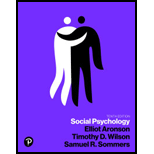
Social Psychology (10th Edition)
10th Edition
ISBN: 9780134700724
Author: ARONSON
Publisher: PEARSON
expand_more
expand_more
format_list_bulleted
Question
Chapter 10, Problem 1RQ2
Summary Introduction
Introduction
In our modern world we are always connected. But are we? Our smartphones, and the connectivity they allow us, have become so important in our lives that they have even come to interfere with our interactions with other people. The mere presence of technological devices like phones has been demonstrated to be a distraction from face-to-face communication, even if they are not actually being used.
Expert Solution & Answer
Want to see the full answer?
Check out a sample textbook solution
Students have asked these similar questions
Add ten years to today. Write the top news story for that day.
Describe how the JTTF has changed interagency investigations.
References please.
Describe how the Joint Terrorism Task Force has changed interagency investigations.
Chapter 10 Solutions
Social Psychology (10th Edition)
Ch. 10 - Prob. 1RQ1Ch. 10 - Prob. 2RQ1Ch. 10 - Prob. 3RQ1Ch. 10 - Prob. 4RQ1Ch. 10 - Prob. 5RQ1Ch. 10 - Prob. 6RQ1Ch. 10 - Prob. 7RQ1Ch. 10 - Prob. 1RQ2Ch. 10 - Prob. 2RQ2Ch. 10 - Prob. 3RQ2
Ch. 10 - Prob. 1RQ3Ch. 10 - Prob. 2RQ3Ch. 10 - Prob. 3RQ3Ch. 10 - Prob. 4RQ3Ch. 10 - Prob. 5RQ3Ch. 10 - Prob. 1RQ4Ch. 10 - Prob. 2RQ4Ch. 10 - Prob. 3RQ4Ch. 10 - Prob. 4RQ4Ch. 10 - Prob. 1SWCh. 10 - Prob. 1TYCh. 10 - Prob. 2TYCh. 10 - Prob. 3TYCh. 10 - Prob. 4TYCh. 10 - Prob. 5TYCh. 10 - Prob. 6TYCh. 10 - Prob. 7TYCh. 10 - Prob. 8TYCh. 10 - Prob. 9TYCh. 10 - Prob. 10TY
Knowledge Booster
Similar questions
- Does the Joint Terrorism Task Force benefit local law enforcement? References please.arrow_forwardWhat are the objectives of the JTTF (Joint Terrorism Task Forces)? References please.arrow_forward- design a lesson plan for a child with a communication disorder who is bilingual. Choose the child’s second language and design a way to bring that language into the lesson plan. How can you help the child see their bilingualism in your teaching? use this as a refernce: https://www.canva.com/design/DAGE-urNdL8/UTP3C4xG4RzyD-pjomxPSQ/editarrow_forward
- Humanized answers, couple sentences each: What are some characteristics of children with speech and language disorders, and how can the information processing model (IPM) help us understand their strengths and challenges? Why must a child’s culture and linguistic background be factored in when assessments and services are determined? How do other disability areas impact communication, language, and speech disorders? What educational responses are needed to support children with speech, language, and communication disorders? What family and life course issues are important for individuals with speech, language, and/or communication disorders?arrow_forwardHow did the public react to the July 4, 2011 case of a San Francisco BART police shooting?arrow_forwardWhat was the eventual outcome of the July 4, 2011 San Francisco BART police shooting?arrow_forward
- How did the media cover the San Francisco BART police officer shooting on July 4, 2011?arrow_forwardHow did the police react to the case of the San Francisco BART police shooting on July 4, 2011?arrow_forward1-Why is it essential for all societies to have mechanisms of social control? 2-What are some examples of illegitimate opportunity structures? What social conditions make these circumstances possible? 3-What social bonds in your own life have influenced your choices and prevented engagement in deviant behavior? 4-How does an individual transition from primary deviance to secondary deviance? Provide an example.arrow_forward
- List 10 significant changes in U.S. federal, state, and local law enforcement as a result of the 9/11 terrorist attacks on U.S. soil. Please include references.arrow_forwardWhy is it essential for all societies to have mechanisms of social control? What are some examples of illegitimate opportunity structures? What social conditions make these circumstances possible? What social bonds in your own life have influenced your choices and prevented engagement in deviant behavior? How does an individual transition from primary deviance to secondary deviance? Provide an example.arrow_forwardCompare and contrast linguistic context and situational context.arrow_forward
arrow_back_ios
SEE MORE QUESTIONS
arrow_forward_ios
Recommended textbooks for you
 Social Psychology (10th Edition)SociologyISBN:9780134641287Author:Elliot Aronson, Timothy D. Wilson, Robin M. Akert, Samuel R. SommersPublisher:Pearson College Div
Social Psychology (10th Edition)SociologyISBN:9780134641287Author:Elliot Aronson, Timothy D. Wilson, Robin M. Akert, Samuel R. SommersPublisher:Pearson College Div Introduction to Sociology (Eleventh Edition)SociologyISBN:9780393639407Author:Deborah Carr, Anthony Giddens, Mitchell Duneier, Richard P. AppelbaumPublisher:W. W. Norton & Company
Introduction to Sociology (Eleventh Edition)SociologyISBN:9780393639407Author:Deborah Carr, Anthony Giddens, Mitchell Duneier, Richard P. AppelbaumPublisher:W. W. Norton & Company The Basics of Social Research (MindTap Course Lis...SociologyISBN:9781305503076Author:Earl R. BabbiePublisher:Cengage Learning
The Basics of Social Research (MindTap Course Lis...SociologyISBN:9781305503076Author:Earl R. BabbiePublisher:Cengage Learning Criminalistics: An Introduction to Forensic Scien...SociologyISBN:9780134477596Author:Saferstein, RichardPublisher:PEARSON
Criminalistics: An Introduction to Forensic Scien...SociologyISBN:9780134477596Author:Saferstein, RichardPublisher:PEARSON Sociology: A Down-to-Earth Approach (13th Edition)SociologyISBN:9780134205571Author:James M. HenslinPublisher:PEARSON
Sociology: A Down-to-Earth Approach (13th Edition)SociologyISBN:9780134205571Author:James M. HenslinPublisher:PEARSON Society: The Basics (14th Edition)SociologyISBN:9780134206325Author:John J. MacionisPublisher:PEARSON
Society: The Basics (14th Edition)SociologyISBN:9780134206325Author:John J. MacionisPublisher:PEARSON

Social Psychology (10th Edition)
Sociology
ISBN:9780134641287
Author:Elliot Aronson, Timothy D. Wilson, Robin M. Akert, Samuel R. Sommers
Publisher:Pearson College Div

Introduction to Sociology (Eleventh Edition)
Sociology
ISBN:9780393639407
Author:Deborah Carr, Anthony Giddens, Mitchell Duneier, Richard P. Appelbaum
Publisher:W. W. Norton & Company

The Basics of Social Research (MindTap Course Lis...
Sociology
ISBN:9781305503076
Author:Earl R. Babbie
Publisher:Cengage Learning

Criminalistics: An Introduction to Forensic Scien...
Sociology
ISBN:9780134477596
Author:Saferstein, Richard
Publisher:PEARSON

Sociology: A Down-to-Earth Approach (13th Edition)
Sociology
ISBN:9780134205571
Author:James M. Henslin
Publisher:PEARSON

Society: The Basics (14th Edition)
Sociology
ISBN:9780134206325
Author:John J. Macionis
Publisher:PEARSON